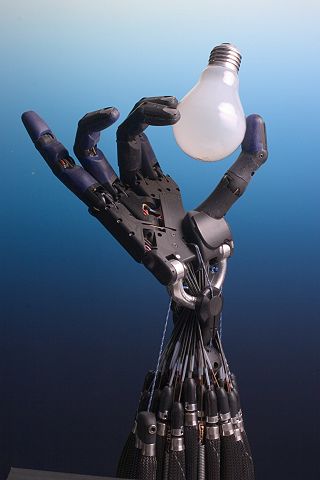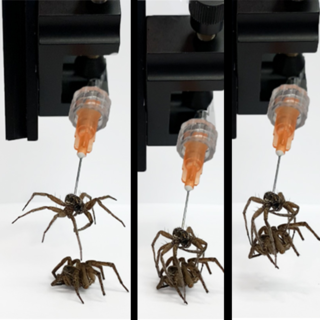Related Research Articles

Microbotics is the field of miniature robotics, in particular mobile robots with characteristic dimensions less than 1 mm. The term can also be used for robots capable of handling micrometer size components.
An actuator is a component of a machine that produces force, torque, or displacement, usually in a controlled way, when an electrical, pneumatic or hydraulic input is supplied to it in a system. An actuator converts such an input signal into the required form of mechanical energy. It is a type of transducer. In simple terms, it is a "mover".

Dario Floreano is a Swiss-Italian roboticist and engineer. He is Director of the Laboratory of Intelligent System (LIS) at the École Polytechnique Fédérale de Lausanne in Switzerland and was the founding director of the Swiss National Centre of Competence in Research (NCCR) Robotics.
Domo is an experimental robot made by the Massachusetts Institute of Technology designed to interact with humans. The brainchild of Jeff Weber and Aaron Edsinger, cofounders of Meka Robotics, its name comes from the Japanese phrase for "thank you very much", domo arigato, as well as the Styx song, "Mr. Roboto". The Domo project was originally funded by NASA, and has now been joined by Toyota in funding robot's development.

A mobile robot is an automatic machine that is capable of locomotion. Mobile robotics is usually considered to be a subfield of robotics and information engineering.

Metin Sitti is the Director of the Physical Intelligence Department at the Max Planck Institute for Intelligent Systems in Stuttgart, which he founded in 2014. He is also a Professor in the Department of Information Technology and Electrical Engineering at ETH Zurich, a Professor at the School of Medicine and College of Engineering at Koç University and co-founder of Setex Technologies Inc. based in Pittsburgh, USA.
Modular self-reconfiguring robotic systems or self-reconfigurable modular robots are autonomous kinematic machines with variable morphology. Beyond conventional actuation, sensing and control typically found in fixed-morphology robots, self-reconfiguring robots are also able to deliberately change their own shape by rearranging the connectivity of their parts, in order to adapt to new circumstances, perform new tasks, or recover from damage.
Neurorobotics is the combined study of neuroscience, robotics, and artificial intelligence. It is the science and technology of embodied autonomous neural systems. Neural systems include brain-inspired algorithms, computational models of biological neural networks and actual biological systems. Such neural systems can be embodied in machines with mechanic or any other forms of physical actuation. This includes robots, prosthetic or wearable systems but also, at smaller scale, micro-machines and, at the larger scales, furniture and infrastructures.

Daniela L. Rus is a roboticist and computer scientist, Director of the MIT Computer Science and Artificial Intelligence Laboratory (CSAIL), and the Andrew and Erna Viterbi Professor in the Department of Electrical Engineering and Computer Science (EECS) at the Massachusetts Institute of Technology. She is the author of the books Computing the Future and The Heart and the Chip.

Robotics is the interdisciplinary study and practice of the design, construction, operation, and use of robots.
The following outline is provided as an overview of and topical guide to robotics:
A plantoid is a robot or synthetic organism designed to look, act and grow like a plant. The concept was first scientifically published in 2010 and has so far remained largely theoretical. Plantoids imitate plants through appearances and mimicking behaviors and internal processes. A prototype for the European Commission is now in development by сonsortium of the following scientists: Dario Floreano, Barbara Mazzolai, Josep Samitier, Stefano Mancuso.
Robotic sensing is a subarea of robotics science intended to provide sensing capabilities to robots. Robotic sensing provides robots with the ability to sense their environments and is typically used as feedback to enable robots to adjust their behavior based on sensed input. Robot sensing includes the ability to see, touch, hear and move and associated algorithms to process and make use of environmental feedback and sensory data. Robot sensing is important in applications such as vehicular automation, robotic prosthetics, and for industrial, medical, entertainment and educational robots.

Bio-inspired robotic locomotion is a fairly new subcategory of bio-inspired design. It is about learning concepts from nature and applying them to the design of real-world engineered systems. More specifically, this field is about making robots that are inspired by biological systems, including Biomimicry. Biomimicry is copying from nature while bio-inspired design is learning from nature and making a mechanism that is simpler and more effective than the system observed in nature. Biomimicry has led to the development of a different branch of robotics called soft robotics. The biological systems have been optimized for specific tasks according to their habitat. However, they are multifunctional and are not designed for only one specific functionality. Bio-inspired robotics is about studying biological systems, and looking for the mechanisms that may solve a problem in the engineering field. The designer should then try to simplify and enhance that mechanism for the specific task of interest. Bio-inspired roboticists are usually interested in biosensors, bioactuators, or biomaterials. Most of the robots have some type of locomotion system. Thus, in this article different modes of animal locomotion and few examples of the corresponding bio-inspired robots are introduced.
The term “soft robots” designs a broad class of robotic systems whose architecture includes soft elements, with much higher elasticity than traditional rigid robots. Articulated Soft Robots are robots with both soft and rigid parts, inspired to the muscloloskeletal system of vertebrate animals – from reptiles to birds to mammalians to humans. Compliance is typically concentrated in actuators, transmission and joints while structural stability is provided by rigid or semi-rigid links.
A continuum robot is a type of robot that is characterised by infinite degrees of freedom and number of joints. These characteristics allow continuum manipulators to adjust and modify their shape at any point along their length, granting them the possibility to work in confined spaces and complex environments where standard rigid-link robots cannot operate. In particular, we can define a continuum robot as an actuatable structure whose constitutive material forms curves with continuous tangent vectors. This is a fundamental definition that allows to distinguish between continuum robots and snake-arm robots or hyper-redundant manipulators: the presence of rigid links and joints allows them to only approximately perform curves with continuous tangent vectors.

A biohybrid microswimmer also known as biohybrid nanorobot, can be defined as a microswimmer that consist of both biological and artificial constituents, for instance, one or several living microorganisms attached to one or various synthetic parts.

A microswimmer is a microscopic object with the ability to move in a fluid environment. Natural microswimmers are found everywhere in the natural world as biological microorganisms, such as bacteria, archaea, protists, sperm and microanimals. Since the turn of the millennium there has been increasing interest in manufacturing synthetic and biohybrid microswimmers. Although only two decades have passed since their emergence, they have already shown promise for various biomedical and environmental applications.

Necrobotics is the practice of using biotic materials as robotic components. In July 2022, researchers in the Preston Innovation Lab at Rice University in Houston, Texas published a paper in Advanced Science introducing the concept and demonstrating its capability by repurposing dead spiders as robotic grippers and applying pressurized air to activate their gripping arms.

A peristaltic robot, also known as a worm-bot, is a robot that uses peristaltic locomotion to move, mimicking the movement of earthworms. Peristaltic locomotion relies on compressions and expansions of the metameres, or body segments, of earthworms. This method of movement is especially effective in navigating through narrow and intricate surfaces, making it particularly suitable for small millimeter-scale robots. Peristaltic robots have a wide range of applications, including endoscopy, mining operations, and pipe inspections.
References
- ↑ P. Thomson, “An Exhaustive History of Robotics,” G2, Aug. 30, 2019. https://www.g2.com/articles/history-of-robots (accessed Oct. 30, 2023).
- ↑ "Adaptable robots 'on their way' to the home". BBC News. 2015-05-27. Retrieved 2023-11-09.
- 1 2 3 Content, Sponsored (2019-07-29). "Why Adaptive Robots are the Next Big Thing". Robotics Business Review. Retrieved 2023-11-09.
- 1 2 3 4 P. Thomson, “An Exhaustive History of Robotics,” G2, Aug. 30, 2019. https://www.g2.com/articles/history-of-robots (accessed Oct. 30, 2023).
- ↑ "Actuators: what is it, definition, types and how does it work". Progressive Automations. Retrieved 2023-11-09.
- ↑ Chi, Yinding; Zhao, Yao; Hong, Yaoye; Li, Yanbin; Yin, Jie (February 2024). "A Perspective on Miniature Soft Robotics: Actuation, Fabrication, Control, and Applications". Advanced Intelligent Systems. 6 (2). doi: 10.1002/aisy.202300063 .
- ↑ "Benefits of programmable robot kits for beginners". Twit IQ. 2022-06-22. Retrieved 2023-06-26.
- ↑ Tokhi, Mohammad; Gurvinder, Virk (2016). Advances In Cooperative Robotics - Proceedings Of The 19th International Conference On Clawar 2016. Hackensack, NJ: World Scientific. p. 159. ISBN 9789813149120.
- ↑ Xiao, Wei; Liu, Chang; Hu, Dean; Yang, Gang; Han, Xu (April 2022). "Soft robotic surface enhances the grasping adaptability and reliability of pneumatic grippers". International Journal of Mechanical Sciences. 219: 107094. doi:10.1016/j.ijmecsci.2022.107094.
- ↑ Chi, Yinding; Zhao, Yao; Hong, Yaoye; Li, Yanbin; Yin, Jie (February 2024). "A Perspective on Miniature Soft Robotics: Actuation, Fabrication, Control, and Applications". Advanced Intelligent Systems. 6 (2). doi: 10.1002/aisy.202300063 .
- ↑ Yim, Mark; Zhang, Ying; Duff, David (1 February 2002). "Modular Robots". IEEE Spectrum.
- 1 2 3 Iglesias, Andrés; Gálvez, Akemi; Suárez, Patricia (2020). "Swarm robotics – a case study: Bat robotics". Nature-Inspired Computation and Swarm Intelligence. pp. 273–302. doi:10.1016/B978-0-12-819714-1.00026-9. ISBN 978-0-12-819714-1.
- 1 2 3 Conocimiento, Ventana al (2019-10-21). "Biohybrid robots, the next step in the robotic revolution". OpenMind. Retrieved 2023-11-09.
- 1 2 Teng, Tao; Gatti, Matteo; Poni, Stefano; Caldwell, Darwin; Chen, Fei (June 2023). "Fuzzy dynamical system for robot learning motion skills from human demonstration". Robotics and Autonomous Systems. 164: 104406. doi:10.1016/j.robot.2023.104406.
- 1 2 Okamura, Allison; Mataric, Maja; Christensen, Henrik (September 2010). "Medical and Health-Care Robotics". IEEE Robotics & Automation Magazine. 17 (3): 26–37. doi:10.1109/MRA.2010.937861. hdl: 1853/37375 .
- 1 2 3 Soori, Mohsen; Arezoo, Behrooz; Dastres, Roza (2023). "Artificial intelligence, machine learning and deep learning in advanced robotics, a review". Cognitive Robotics. 3: 54–70. doi: 10.1016/j.cogr.2023.04.001 .
